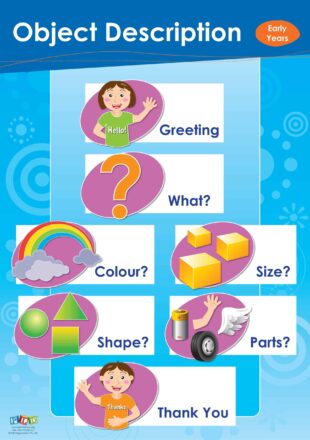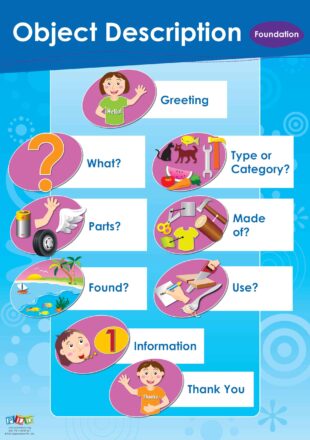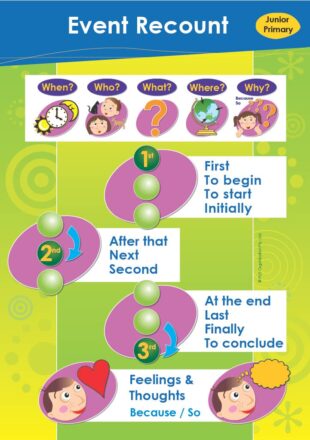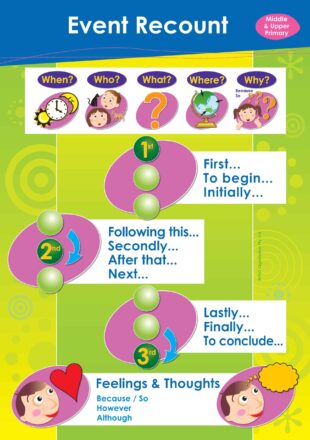Oral language instruction should be an essential component of writing programs. Prior to and once students are able to write, effective oral language instruction helps to increase the sophistication of written vocabulary, sentence structure, and the elaboration of ideas. To encourage the explicit instruction of oral language across classrooms, PLD’s oral language program has made oral language posters available to download. Each download contains 4 or 5 posters to use in your oral language program Early Years, Foundation, Year 1 & 2 or Year 3, 4, 5 & 6 classrooms.
Download Oral Language Posters
- Event-based news (for Early Years, Foundation and Years 1 & 2) and journal writing with event recounts (for Year 3, 4, 5 & 6).
- Object description (for Early Years, Foundation and Years 1 & 2) and simple reports (for Year 3, 4, 5 & 6)
- Three-step activity retells (for Early Years, Foundation and Years 1 & 2) and procedural narratives posters (for Year 3, 4, 5 & 6).
- Simplistic narrative retell posters (for the Early Years, Foundation and Year 1 & 2 ) and increasingly complex narrative structure posters (for Year 3, 4, 5 & 6).
These oral language program posters relate to an implementation guide that is found in PLD’s downloadable Teaching Sequence Manuals.
PLD Oral Language Program
In every writing task, your students’ oral language rehearsal and engagement should progress. Several PLD oral language programs includes writing templates:
- First writing Activities suitable for Foundation and Year 1 & 2
- Connecting Oral and Written Language – Step 1 for Year 1 & 2
- Connecting Oral and Written Language – Step 2 for Year 3, 4, 5 & 6
Click on ‘Read more’ to download the PLD oral language program resources below.
About PLD Literacy
PLD provides an Australian, evidence-based approach to Structured Synthetic Phonics (SSP) for primary school educators. Aligned with the Science of Reading, PLD’s SSP approach extends from the junior primary years through to the upper primary years and facilitates a whole school approach.
PLD’s method is derived from the disciplines of speech pathology, occupational therapy and education. As an Australian publisher and professional development provider, PLD advocates that learning outcomes are maximised when students’ literacy, oral language, movement and motor skills are targeted simultaneously.
What is the Evidence Base for PLD?
Evidence-based teaching is now the norm within Australian schools. For our education standards to meet national and international benchmarks, schools need to invest in programs that are supported by research. This ensures schools are investing in what will produce results rather than just implementing what is a ‘fad’, visually appealing, or what has been done for years.
PLD’s Structured Synthetic Phonics (SSP) approach is based on international research and the resources are upgraded as new research becomes available. In addition, our programs are independently assessed by third-party researchers. This research has shown that when PLD programs are used, in conjunction with ongoing professional development and school-wide consistent screening and tracking, measurable differences occur. We would like to share with you three pieces of evidence-based research across three different education scenarios that show the difference that PLD can make to student outcomes.
PLD Underpins High Performance
The 2015 Department of Education Western Australia study, conducted by Professor William Louden, selected nine top-performing schools based on their NAPLAN results and reviewed their processes. The report, “High Performing Primary Schools: What do they have in common?” noted key characteristics included the use of explicit teaching strategies for teaching phonological awareness and phonics. PLD programs were commonly used in the schools investigated. Louden found that high-performing schools have used explicit teaching strategies for teaching phonological awareness and phonics through a Structured Synthetic Phonics program.



 print
print






